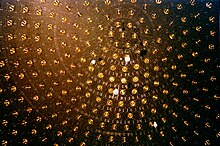
Back عداد نيوترينو Arabic Neutrinový detektor Czech Neutrino-Experiment German ردیاب نوترینو Persian Observatoire de neutrinos French גלאי נייטרינו HE Neutrinska fizika Croatian ニュートリノ検出器 Japanese 중성미자 검출기 Korean Neutrinų teleskopas Lithuanian

A neutrino detector is a physics apparatus which is designed to study neutrinos. Because neutrinos only weakly interact with other particles of matter, neutrino detectors must be very large to detect a significant number of neutrinos. Neutrino detectors are often built underground, to isolate the detector from cosmic rays and other background radiation.[1] The field of neutrino astronomy is still very much in its infancy – the only confirmed extraterrestrial sources as of 2018[update] are the Sun and the supernova 1987A in the nearby Large Magellanic Cloud. Another likely source (three standard deviations)[2] is the blazar TXS 0506+056 about 3.7 billion light years away. Neutrino observatories will "give astronomers fresh eyes with which to study the universe".[3]
Various detection methods have been used. Super Kamiokande is a large volume of water surrounded by phototubes that watch for the Cherenkov radiation emitted when an incoming neutrino creates an electron or muon in the water. The Sudbury Neutrino Observatory was similar, but used heavy water as the detecting medium. Other detectors have consisted of large volumes of chlorine or gallium which are periodically checked for excesses of argon or germanium, respectively, which are created by neutrinos interacting with the original substance. MINOS used a solid plastic scintillator watched by phototubes; Borexino uses a liquid pseudocumene scintillator also watched by phototubes; and the NOνA detector uses a liquid scintillator watched by avalanche photodiodes.
The proposed acoustic detection of neutrinos via the thermoacoustic effect is the subject of dedicated studies done by the ANTARES, IceCube, and KM3NeT collaborations.
- ^ Cite error: The named reference
Chang-2005-04-26was invoked but never defined (see the help page). - ^ Cite error: The named reference
IceCube2018awas invoked but never defined (see the help page). - ^ Cite error: The named reference
Sample-2011-01-23was invoked but never defined (see the help page).